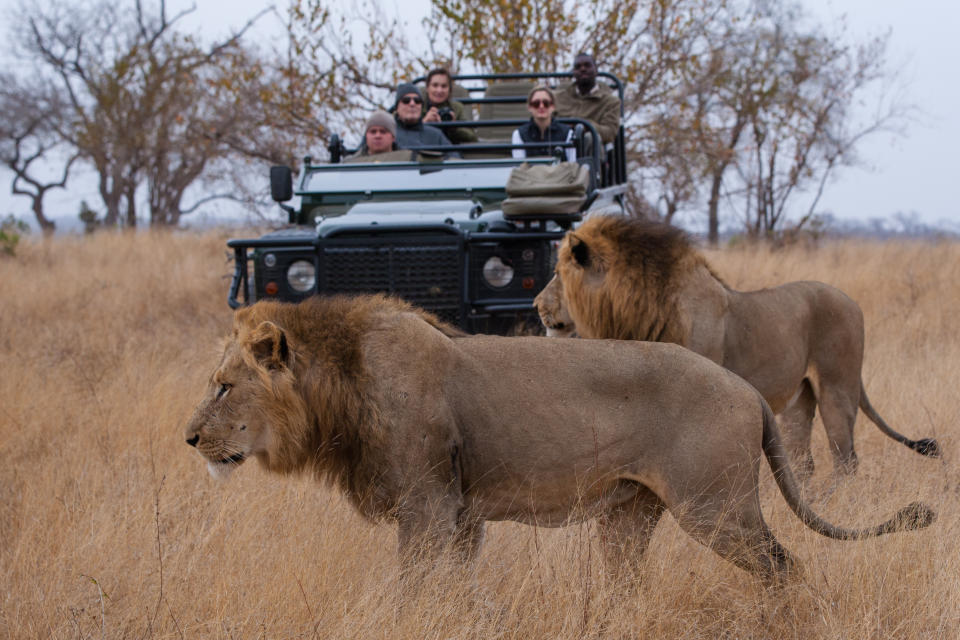'$20 per scalp': Dingo bounty flyer sparks concern over animal's future
An official flyer offering a bounty on dingo scalps has caused a swell of online anger with people comparing the scheme to a program that wiped out the thylacine.
Queensland’s North Burnett Regional Council confirmed the leaflet originated in 2014, but the program was still active.
“Bounty is set at $20 per scalp,” the flyer says.
“Claimants must present a dry scalp from snout to tail… pieces of fur will not be accepted.”
The flyer includes pictures of dried dingo skins in order to illustrate how shooters should present the animals for bounty collection.

Despite the flyer being online for six years, the swell of criticism only erupted this week.
The flyer was reposted to multiple social media pages as interest in Australia’s wildlife grows amid devastating bushfires, which have killed more than a billion native animals.
“What the hell age are we in? Back in the 1880s? Scalps. Serious?” one person wrote.
“Thylacine died the same way,” another person said.
A third person wrote: “Agreed just kill, kill, kill. Never stops.”
Branded as wild dogs instead of dingoes
Evan Quartermain, from Humane Society International, said it was distressing that governments and councils were still killing dingoes, believing it would protect stock.
“We should not be spending our money blunt indiscriminate killing,” he told Yahoo News Australia.
“Investment should be directed towards developing more humane and non-lethal alternatives, as dingoes have an important regulatory function as apex predators in the environment.
“Baiting is an unsophisticated approach that’s shown to be ineffective and although the intention is seemingly well meaning to protect stock animals, there’s very little evidence that it’s effective in doing so.”

Mr Quartermain is surprised the flyer publicly offers a bounty on dingoes, noting most governments describe the species as “wild dogs” to make their slaughter more acceptable.
The “wild dog” moniker remains despite research published in 2019 by the University of NSW finding the majority of dingoes killed in NSW were were genetically pure or dingo-dominant hybrids.
“The relationship between people and predators is always a complex one, but internationally we see a lot of respect for wolves and bears in Europe and America or lions in Africa,” Mr Quartermain said.
“When it comes to Australia there’s this attitude in some circles are an introduced pest or they’re branded as wild dogs instead of dingoes.
“They are ‘othered’ to make the killing of them more palatable.”

The North Burnett Regional Council responded to questions about its dingo bounty policy by directing Yahoo News Australia to its general policy on wild dog and dingo management.
The document recognises the need for society to co-exist with dingoes as an apex predator, but notes the animals have been declared an invasive animal that must be destroyed in Queensland.
As a result they utilise scalp bounties, baiting and trapping when “significant negative impacts” are identified.
Bushfire recovery to include dingo poisoning in NSW
Many of those critical of council’s flyer online pointed out the NSW government is dropping thousands of poisonous 1080 baits as part of its bushfire recovery plan.
The program will use $1 million in emergency funding as part of a $6.5 million investment to support and care for injured wildlife.
Funds will be used to complete aerial baiting of an area up to 60,000 kilometres as well as localised follow up ground shooting.
NSW Animal Justice Party MLC Emma Hurst told Yahoo News Australia that unless governments stopped baiting the dingo could end up extinct on mainland Australia.

"Dingoes have been in living in Australia for over 4000 years. They are intelligent, sentient animals, with the ability to feel pain and to suffer in a similar way to humans,” she said.
“Yet our government continues to allow them to be killed using the cruellest and most dangerous method possible: poisoning by 1080.
"Like any animal unfortunate enough to be poisoned with this indiscriminate bait, dingoes face a traumatic and painful death after consuming 1080.”
Woman perplexed by cute creature she found in her yard - can you tell what it is?
'It smells like death': Koalas bulldozed on Victorian property
Outrage over plan to bulldoze 'Bear Hill' koala habitat amid bushfire crisis
'Exploited by an old rule': Loophole closed to protect Aussie icon
Ms Hurst said 1080 poisoning causes its victims to vomit, shake, scream, writhe and slowly die over a four-day period.
She added killing dingoes could actually be doing harm to the genetics of the wider population.
"The current status of dingo populations in NSW is considered by the state government to be uncertain,” she said.
“What the government fails to recognise is that their use of the 1080 toxin is increasing the hybridisation of dingoes with wild dogs, forcing them to interbreed as their family groups are poisoned.
"It is unconscionable that our state government continues to drop 1080 baits in Kosciuszko National Park, the home to one of the most important remaining populations of pure dingoes in Australia.”
Baiting designed to ‘save’ native animals
The NSW Department of Environment responded to questions about aerial baiting with a statement saying the program’s focus is foxes.
The department said the plan is designed to “save a large number of native animals” from fox predation and restore wildlife populations.
“Aerial baiting for wild dogs will be designed to avoid core remote areas, allowing dingoes to maintain their ecological function in these areas,” the statement read.
“Most native animals such as lace monitors and birds have a high tolerance to 1080 as it naturally occurs in native vegetation.
“Research has shown that aerial baiting does not impact quoll populations.”
Do you have a story tip? Email: newsroomau@yahoonews.com.
You can also follow us on Facebook, Instagram and Twitter and download the Yahoo News app from the App Store or Google Play.




